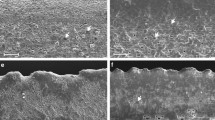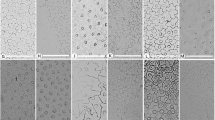Abstract
The study of new material on Ginkgo tzagajanica Samylina and earlier published data has shown that the epidermal morphology of the species in highly variable; several new characters were found. Occurrence of different states of characters was analyzed, their frequency distribution was revealed, and typical and rare states of characters within variation rows were determined. The specific diagnosis of G. tzagajanica was emended. The most variable characters are degree of undulation of the anticlinal walls of cells of abaxial and adaxial epidermises (the latter is more variable) and degree of development and number of papillae on ordinary epidermal cells. Less variable characters are degree of development of papillae on subsidiary cells of stomata and how the papillae cover the stomatal apertures. These are characters that bear maximal diagnostic significance for Cenozoic Ginkgo.
Similar content being viewed by others
References
M. A. Akhmetiev, T. V. Kezina, T. M. Kodrul, and S. R. Manchester, “Stratigraphy and Flora of the Cretaceous-Paleogene Boundary Beds in the Southeastern Part of the Zeya-Bureya Sedimentary Basin,” in Collection of Papers in Memory of Corresponding Member of the Russian Academy of Sciences Prof. V.A. Vakhrameev on Occasion of His 90th Birthday (GEOS, Moscow, 2002), pp. 275–315 [in Russian].
M. C. Boulter and Z. Kvaček, “The Paleocene Flora of the Isle of Mull,” Spec. Pap. Palaeontol. 42, 1–149 (1989).
L. Yu. Budantsev, History of the Arctic Flora of the Early Cenophytic Epoch (Nauka, Leningrad, 1983) [in Russian].
T. Denk and D. Velitzelos, “First Evidence of Epidermal Structures of Ginkgo from the Mediterranean Tertiary,” Rev. Palaeobot. Palynol. (120), 1–15 (2002).
R. Florin, “Die fossilen Ginkgophyten von Franz-Joseph-Land nebst Erörterung über vermeintlich Cordaitales mesozoischen Alters. I. Spezieller Teil,” Palaeontogr. B 81(3–6), 71–173 (1936).
R. Florin, “Die fossilen Ginkgophyten von Franz-Joseph-Land nebst Erörterung über vermeintlich Cordaitales mesozoischen Alters. II. Algemeiner Teil,” Palaeontogr. B 82(1–4), 1–72 (1937).
T. M. Harris, “The Fossil Flora of Scoresby Sound, Greenland. Part IV,” Medd. om Grønland 112(1), 1–176 (1935).
O. Heer, “Miocene Flora der Insel Sachalin,” Mém. Acad. Imp. Sci. Saint-Pétersb., Ser. 7, 25, 1–61 (1878).
R. S. Hill and R. J. Carpenter, “Ginkgo Leaves from Palaeogene Sediments in Tasmania,” Aust. J. Bot. 47, 717–724 (1999).
Horiuchi J. and Kimura T., “Ginkgo tzagajanica Samylina from the Palaeogene Noda Group, Northeast Japan, with Special Reference to Its External Morphology and Cuticular Features,” Trans. Proc. Palaeontol. Soc. Japan, N. S., No. 142, 341–353 (1986).
A. M. Kamaeva, Stratigraphy and Flora of the Cretaceous-Paleogene Boundary Beds of the Zeya-Bureya Depression (Dal’nevost. Otd. Akad. Nauk SSSR, Khabarovsk, 1990) [in Russian].
S. V. Konstantov, “Tertiary Flora of the Belogorsk Outcrop in the Lower Reaches of the Bureya River,” Tr. Geol. Kom., Nov. Ser., No. 113, 1–27 (1914).
V. A. Krassilov, Tsagayan Flora of the Amur Region (Nauka, Moscow, 1976) [in Russian].
A. N. Kryshtofovich and T. N. Baikovskaya, “Upper Cretaceous Tsagayan Flora in the Amur Region,” in A.N. Kryshtofovich: Selected Papers (Akad. Nauk SSSR, Moscow-Leningrad, 1966), Vol. 3, pp. 184–320 [in Russian].
S. Manum, “Ginkgo spitsbergensis n. sp. from the Paleocene of Spitsbergen and a Discussion of Certain Tertiary Species of Ginkgo from Europe and North America,” Norsk Polarinst. Årb. 1965, 49–58 (1966).
Oishi S., “On the Cuticles of Tertiary Ginkgoites Leaves from Kuzi, Iwate Prefecture,” J. Fac. Sci. Hokk. Univ. Ser. IV 4(1–2), 103–106 (1938).
M. S. Pole and J. G. Douglas, “Bennettitales, Cycadales, and Ginkgoales from the Mid-Cretaceous of the Eromanga Basin, Queensland, Australia,” Cret. Res. 20, 523–538 (1999).
V. A. Samylina, “On the Final Stages of the History of the Genus Ginkgo L. in Eurasia,” Bot. Zh. 52(3), 303–316 (1967).
V. A. Samylina and A. I. Chelebaeva, “New Data on the Tertiary Species of Ginkgo in Soviet Eastern Asia,” Paleontol. Zh., No. 2, 97–102 (1986).
H. Tralau, “Evolutionary Trends in the Genus Ginkgo,” Lethaia 1, 63–101 (1968).
F. Unger, Synopsis Plantarum Fossilium (Leopold Voss, Leipzig, 1845).
Zhou Z., “Mesozoic Ginkgoalean Megafossils: A Systematic Review,” in Ginkgo biloba-A Global Treasure: From Biology to Medicine, Ed. by Hori T. et al. (Springer-Verlag, Tokyo, 1997), pp. 183–206.
Author information
Authors and Affiliations
Corresponding author
Additional information
Original Russian Text © L.B. Golovneva, 2010, published in Paleontologicheskii Zhurnal, 2010, No. 5, pp. 99–107.
Rights and permissions
About this article
Cite this article
Golovneva, L.B. Variability in epidermal characters of Ginkgo tzagajanica Samylina (Ginkgoales) from the Paleocene of the Tsagayan formation (Amur Region) and the taxonomy of tertiary species of Ginkgo . Paleontol. J. 44, 584–594 (2010). https://doi.org/10.1134/S003103011005014X
Received:
Published:
Issue Date:
DOI: https://doi.org/10.1134/S003103011005014X




